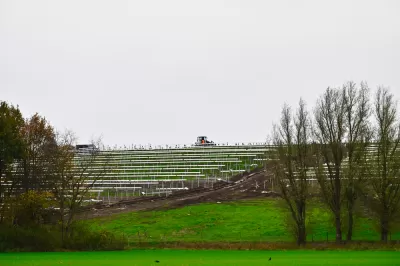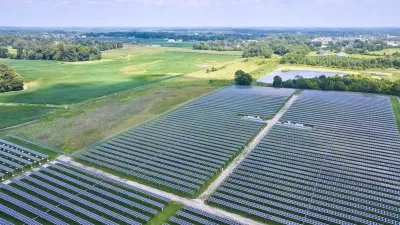Incentives aimed at brownfield development of renewable energy projects could give momentum to building solar farms on an underutilized property: closed municipal landfills.

A new tax credit created through the Inflation Reduction Act (IRA) could boost the construction of solar farms on shuttered landfills and other brownfield sites, which could reduce the impact of solar installations on virgin land and make renewable energy production accessible to more communities.
As Taylor Kate Brown explains in a Governing article, closed landfills offer unique challenges and unique opportunities. They are often owned by local governments, have strong sun exposure, and are unsuitable for other types of development, making them a logical site for energy production. “But placing solar modules on these sites requires a different kind of installation: a ballasted system that doesn’t drive foundations deep into the ground, avoiding piercing the landfill cap and unsettling the waste below,” Brown explains.
The success of subsidies and incentives for renewable energy production offered by state governments indicates that the federal tax break could encourage more brownfield development of clean energy projects. After Massachusetts created subsidies for renewable energy projects located on landfills, the state, which only has 7 percent of the nation’s landfills, became home to 52 percent of U.S. utility-scale landfill solar projects. Now, municipalities that previously rejected solar landfill projects due to cost or complications are revisiting the idea.
FULL STORY: Why Aren’t More Solar Farms Built on Municipal Landfills?

Trump Administration Could Effectively End Housing Voucher Program
Federal officials are eyeing major cuts to the Section 8 program that helps millions of low-income households pay rent.

Planetizen Federal Action Tracker
A weekly monitor of how Trump’s orders and actions are impacting planners and planning in America.

Ken Jennings Launches Transit Web Series
The Jeopardy champ wants you to ride public transit.

Why Bike Lanes Are Good: An Explainer for the US Transportation Secretary
Sean Duffy says there’s no evidence that bike lanes have benefits. Streetsblog — and federal agencies’ own data — beg to differ.

California Invests Additional $5M in Electric School Buses
The state wants to electrify all of its school bus fleets by 2035.

Austin Launches $2M Homelessness Prevention Fund
A new grant program from the city’s Homeless Strategy Office will fund rental assistance and supportive services.
Urban Design for Planners 1: Software Tools
This six-course series explores essential urban design concepts using open source software and equips planners with the tools they need to participate fully in the urban design process.
Planning for Universal Design
Learn the tools for implementing Universal Design in planning regulations.
Ada County Highway District
Clanton & Associates, Inc.
Jessamine County Fiscal Court
Institute for Housing and Urban Development Studies (IHS)
City of Grandview
Harvard GSD Executive Education
Toledo-Lucas County Plan Commissions
Salt Lake City
NYU Wagner Graduate School of Public Service





























